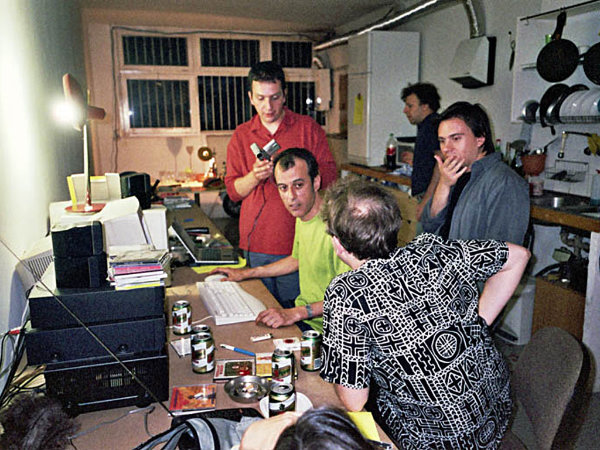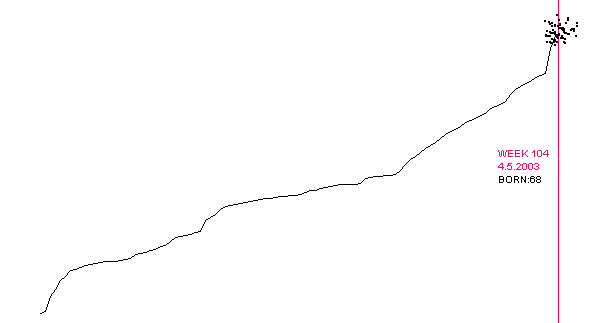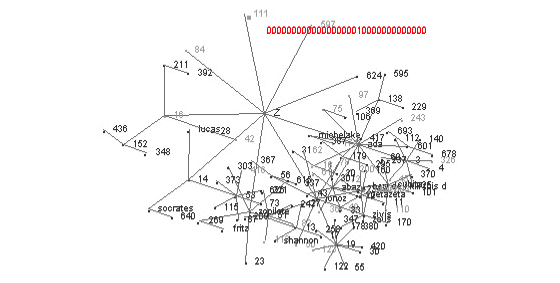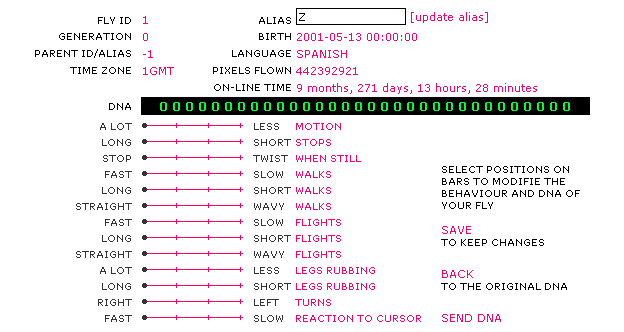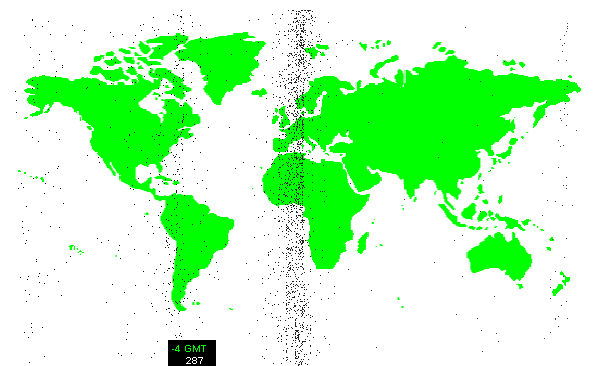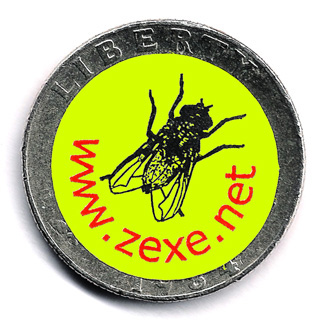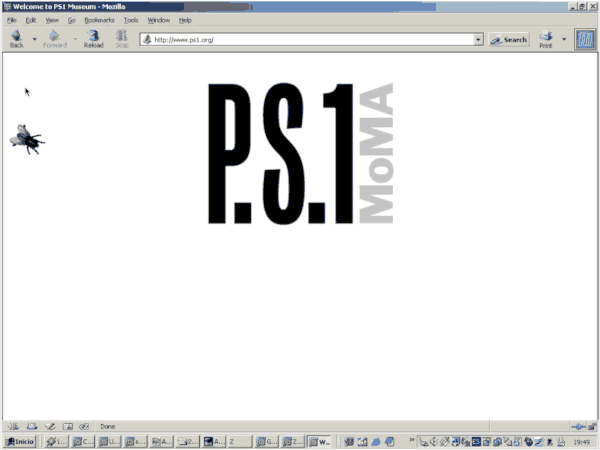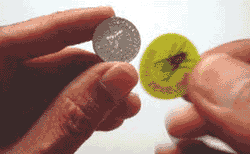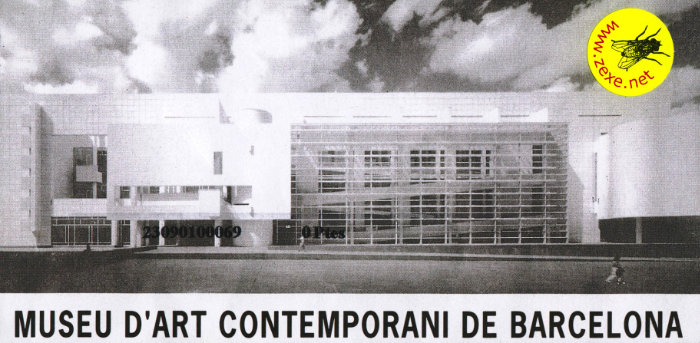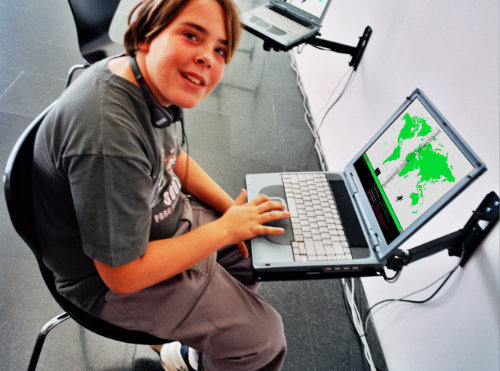Ethology of Z
A digital fly called Z is propagated in the web, parasiting computers around the world with their users consent. We are talking about the computer program known as Z, which intervenes in the operating system and the user interface of all types of personal computers.
Z.exe is a program that manifests itself visually and acoustically as a fly. Z is an agent infiltrated into the user interface. The user interface is the audiovisual system that permits a person and a computer to communicate with each other. The images and sounds that make up the interface tend to have associated functions that unleash certain processes. The results of these processes are also made manifest on the screen and through the speakers; they too make up part of the interface.
Z and the metaphor of the desktop
Z lives in the desktop when the computer is connected to the web. The desktop is the visual metaphor that structures
the information on the screen, a metaphor that speaks to us of order and productivity, with its iconic display of documents, files and the wastebasket.
The desktop is the visual environment of experience.
The fly flicks about the screen (covering distances that are measurable in pixels), up and down, right and left, negating the illusion of image depth in perspective (as would occur with a fly moving over the lens of a camera), constantly shifting over the surface of the screen, competing with the cursor for this spatial limit.
Z is a fly that dialogues with the cursor
The cursor is the standard icon for resolving the presence of the user at the desktop; it acts as the virtual subject of experience.
As is known, the user cannot interact directly (with his or her body) in the virtual environment, which is why a peripheral apparatus
like the mouse is needed to control the cursor. The movements of the user's hand pushing the mouse forward and backward, right and left,
over the flat plane of the table, are mapped on the icon of the virtual subject (the cursor), which in this way may move over the vertical
plane of the screen.
This relation of identity between the user (brain/eyes/hand) and the system (screen/mouse/cursor), learnt almost intuitively and assimilated by practice to an almost unconscious degree, is the mechanism the relation of the user with the Z is based upon. In fact, if we pay attention to the reaction of the user in the moment Z is installed in the computer and the fly appears for the first time within the private space of the screen, we come to realize that the user response is a reflexive act, almost as old as the gesture of scaring a fly away with an unthinking swipe of the hand, only here translated to the virtuality of the desktop and the extension of the hand as constituted by the cursor. From this moment and this gesture onwards, we can say that the user has integrated the fly.
The fly intervenes in this dynamic in conscious fashion within this logic and thus, with its incursion onto our screen (the most visible part of the system), ends up forcing us, with its insidiously erratic activity, to become conscious of our acts.
Coda
The user interface is thus the immediate context of the fly. It is not however a homogenous context, nor is it
(as the fly will remind us) something dehumanised. The fly takes on diverse connotations in function of the context; the fly
flitting about the wastebasket, the fly walking over the lines of a text we just cannot seem to finish, the fly on the Windows logo,
the fly rubbing its legs over an e-mail bearing bad news, the fly digging away on a pornographic image, the fly immobile on an accounting
sheet that we cannot seem to balance, the fly as an intruder on the Home icon of the navigator.
Everything we have ever poured into our computer (often without thinking), power, colour, smell and taste, recovers its importance a s soon as the fly appears. Z is a program that questions our relation with the computer. Z, as a fly, has the capacity to make our (human) relations with the (digital) environment problematic.
Z and the web
Z, as we have already mentioned, only makes the fly appear on our screen and in our speakers when the computer
is connected to the web. Thus Z is a piece of software designed and made to specifically intervene in person-computer communication
processes, though only in those moments when there is distributed communication.
This fact places Z in the realm of net.art or art online. Yet it is not a piece of web-art (being more like a series of HTML documents placed in a server,) nor is it an e-mail art proposal (though it can propagate like a document attached to an e-mail). Z resembles more the logic of viruses (though its entirely lacking in destructive capacity), or more precisely like so-called bots or agents. Basically, Z is a parasite program that receives and sends information to and from a server. Everyone who has installed Z in the computer and is connected to Internet will come to make up part of a community.
Community
The Z community is a swarm of flies: the growing sum of all the flies installed in the computers of Internet users
throughout the world via multiplication of the mother fly. The community is in constant communication through a server that manages the
traffic of information. The continually updated information on each fly is saved in a registry where a complete statistical task is
carried out, beginning on May 13, 2001, the launching date of the first Beta version of Z. In this dynamic memory, fed by all the
information on the activity of each individual, there is a registry of the births (installations) and deaths (uninstallations),
with the data of the distance travelled by each fly constantly updated, as if it were a measure of flight time. Meanwhile, a detailed
follow-up of the evolution of the swarm over the world is maintained by keeping track of its distribution over different time zones,
not to forget the genealogy of each individual fly: a tree that has its roots in the mother fly.
Z and the genome
The genetic code of the Z mother fly is 0000 0000 0000 0000 0000 0000 0000 0000,
an 8-byte genome resulting in a string of thirty-two zeros. The characteristics of the mother fly, along with all of her
descendents, are thus codified according to the same binary code that might permit individualised control, maintain the
statistical registry of the swarm or even, if so required, clone a concrete individual in the moment the artist decides
to do so.
Yet this is not all; the code of Z is made up of two differentiated segments that its programmers have foreseen both as the basis for the fly's appearance and as a basis for its behaviour. This unusual creative strategy, which goes further into the concept of the program as especially present in the field of art theory in the second half of the 20th century, allows us to anticipate new formulas of seriality related to the metaphor of the gene. In Z the overly abused notion of the code is used directly by its computer condition, and metaphorically in relation to genetics. Thus on the one hand the code is the very essence of Z, inasmuch as it is a computer program, while on the other it is a metaphor where the allegory making up the discourse -if we are to call it that- of the proposal is grounded.
Z and the world
This is not the first time that Antoni Abad has used the world as a support. Already in his first net.art
piece, Sisyphus, the artist centred on taking full advantage of the specific properties of the Internet to refer to what could
not be grasped, the incapacity of the human being in confrontation with the world. The myth of Sisyphus there became the guiding
force behind a tale about incapacity, set across the diameter of the Earth, where using just two antipodal servers (one in Barcelona and
the other in Wellington, New Zealand), the axiom whereby the web overcomes the limits of space and time could be questioned.
With Z Abad once again returns to the world as the support for a work where the multiplication of the mother fly leads to a certain saturation of the map, the darkening of the mental image with which (with all our human limitations) we attempt to encompass all worlds hidden in this world.
Globalised and deglobalising, Antoni Abad's fly is reproduced in its condition as a computer program and its condition as an artistic program. It is globalised inasmuch as it is a computer program that operates in Windows and is reproduced all over the web, its reproductive nature out of control as part of its inherent condition as freeware. It is in turn deglobalising as an artistic program that begins with the singularity of its creator, and addresses itself to the singularity of its potential hosts, the very ones that for one reason or another wish to house a parasite within and propagate it from their systems.
Canal Z
The reasons leading each individual to install Z in his or her computer will always be hidden within the folds of
individuality making up the community as a whole. In any case, these motivations cannot be derived from a commercial notion (.com),
nor from one that is military (.mil), governmental (.gov), educational (.edu), nor related to a specific country.
How then might we explain such motivations when they cannot apparently be generalised, when all we know is that the fly is a useless and unproductive element of the user interface? If it is true that the fly is unproductive, we should keep in mind that currently Z is a program that develops certain functions or services in Internet. It is not in vain that Z is found in http://www.zexe.net, and .net (dot net) is the extension of the domain for Internet service providers. Yet if we think of the definitions of the term service (n. 1. action of serving; 2. task or job done to serve the State or another entity or person), we will find that in Z the only action of serving is carried out by the so-called Canal Z (Channel Z), and consists solely in facilitating an avenue of anonymous textual communication to the members of the community connected to Internet in each given moment.
Thus even though it is (as a matter of principle) an unproductive fly, Z can be considered useful, given that it is a program through which we have access to a community. Yet as this community is made up of anonymous members with its access beyond control, we must admit that Canal Z has a paradoxical character; the service rendered is not useful to anyone in particular, nor is it designed for any other purpose than communication, simply put.
A particular Natural History
With this fly that flies to fly, interacting just to interact, serving nobody in particular just
to communicate, that is, communicates to communicate, Antoni Abad deepens his research into a particular Natural History.
The paradox locked into a natural history (wordlessly) written by an art historian like Antoni Abad, turns over upon itself even more when, as in this case, it refers to artificial species (like the fly of z.exe) that he has created.
Effectively, Abad invites us to participate in an artistic proposal that we can assume as an experience in the terrain of social communication. The artist offers up a particular and unique way of participating in the web. We can understand it as an extension of his sculptural thought, as an expansion of his audiovisual work, or just as well as an investigation into relational aesthetics and their implication for information and communication technologies.
Roc Parés Barcelona 01-10-2001
Presented at Serralves Museum for the International Conference on
Cyberculture
Published at Ligações - Links - Liaisons, Porto 2001.
Revised version. R.P. & A.A.,
February 2022
Z
If there is a "public space" within P.S.1, it is the cafe. While not overwhelmed by visitors from the community, I do know engineers from the city’s Department of Design and Construction who come to eat there. Tom Finkelpearl, June 30, 2001
New York -- 12th October 2003. Frank enters the P.S.1 cafe. He orders a cappuccino and pays with a $5 bill. It’s not his first visit to this Art Centre café. He works as an engineer and he sometimes eats here mid-week with his colleagues from the city’s Department of Design and Construction, although he’s never had time to see any of the exhibitions. Among the small change returned to him with his receipt, his eye is caught by a quarter with a yellow sticker on it, showing a life-size fly. Around this black fly there is a website address: www.zexe.net
Heading for a free table, Frank puts the fly in his pocket. Someone has left a copy of the Village Voice on the table. Today is Sunday, he has spent the best part of the morning visiting some of the works in The Real Royal Trip exhibition and some loose plans for the evening go through his mind: see a movie, go out for dinner... he opens the paper. He sits down and begins to leaf through it, waiting for his cappuccino to cool down. Distractedly, he picks up his cup, takes a sip and burns himself. His eyes screw closed and he pushes the tip of his sore tongue against the back of his bottom teeth. Relaxing and opening his eyelids, he focuses once more on the paper and finds himself looking at more flies. Intrigued, he fishes in his pocket and feels for the infested quarter. He takes it out and sees that the flies in the paper are identical to the first and that they refer him to the same website: www.zexe.net
Draining his cappuccino, he stands up to head home. Leaving the Voice on the table he exits the cafe. Walking along Jackson towards 46th, Frank the engineer thinks about the difference in the traffic on non-working days: it’s not simply a question of weight of traffic, it’s about driver motivation. He reaches the subway on 44th and goes about buying a one-way ticket for the V train. When he pays, without realising, he hands the fly over to the attendant. He walks towards the platform, deep in thought, just like every day, when suddenly he realises that the V train doesn’t run on weekends.
Roc Parés Foixà, Catalonia, Sunday, 6th July 2003.
Published at The Real Royal Trip exhibition catalogue, curated by Harald Szeemann at PS1 MoMA,
New York 2003
La mouche du poste
Depuis mai, un essaim virtuel infeste la Toile avec la complicité des internautes. A l'origine de l'invasion, une mouche digitale baptisée Z qui apparaît sur l'écran dès qu'on lance un petit programme, téléchargeable gratuitement sur www.zexe.net.
Z n'est pas un énième agent virtuel chargé de vous distraire. Quoique, une grosse mouche à merde qui grouille sur l'écran ne favorise pas la concentration. Elle ne vit que lorsque l'utilisateur est connecté au réseau. Un peu comme les vraies mouches qui n'apparaissent que l'été, sourit son créateur, l'artiste catalan Antoni Abad, le reste du temps, elle est invisible et n'interagit pas avec l'ordinateur.
Quand on installe ce programme artistique, on devient automatiquement membre d'une communauté de mouches. On peut voir en temps réel le nombre de ses congénères en ligne, leur nom, leur état (si elles somnolent ou si elles sont actives), et même discuter avec elles par l'intermédiaire d'un chat.
Une chronologie retrace le nombre d'insectes créé chaque jour depuis le lancement du projet. Et sur une mappemonde, l'utilisateur peut suivre, toujours en temps réel, la distribution de l'essaim sur les fuseaux horaires.
A terme, les utilisateurs pourront manipuler le comportement et la morphologie de leur mouche et s'échanger les mutantes à travers la Toile pour un remake numérique de la quatrième plaie d'Egypte.
Manipulation e-génétique
Chaque mouche est unique avec son propre code génétique, ce qui permet de suivre son activité: pixels parcourus, heures de vol, date de
naissance (installation) et de décès (désinstallation). On peut consulter son arbre généalogique, toutes les mouches étant issues d'une
même mère dont le code est une suite de 32 de zéros et de uns.
Marie Lechner Paris, France, vendredi 21 décembre 2001
Libération, n° 6408, TENTATIONS, p. 13
